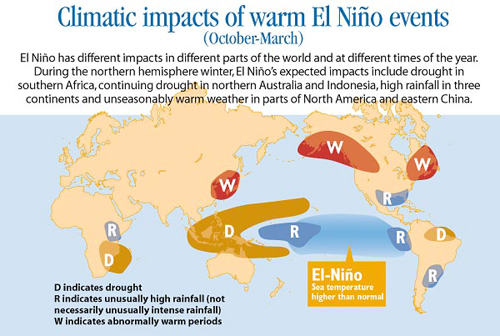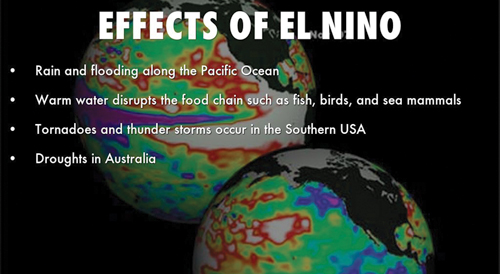How El Nino will impact us
by K.R. Abhayasingha
According to the Gregorian calendar, the year 2016 has commenced. The
last lap of 2015 slipped through us, leaving several serious natural
hazards caused by extremely intense rainfall between October-November of
2015 over most parts of the island.
 |
|
Climate impacts of warm El
Nino effects (ecosystems.wcp.muohio. edu) |
The international climate and geographical institutes reported on a
phenomenon called the El Nino and warned the world that it may be severe
than the 1997 El Nino , the worst to occur during the recent past, and
predicted of extreme weather parameters that can affect most regions of
the world. Local media also devoted space and time to clarify further
through meteorological officials, about El Nino's influence.
Close relationship
El Nino has become a very important topic in the past few decades due
to statistical analyses demonstrating a close relationship between
periodical extreme weather conditions and the El Nino events.
Among the causes for the periodical droughts in Sri Lanka, El Nino
seems to be most important. Not only drought situations in Sri Lanka but
also some extreme weather conditions leading to natural disasters of all
types, locally and globally, are triggered off by El Nino events.
But in the past, El Nino has been regarded as a problem or a disaster
for the fisheries industry in South American villages. For hundreds of
years, fishermen living in coastal villages in Peru and Ecuador have
known El Nino. Once or twice in each decade, the normally cooler waters
along South America's shores would warm and the fish would begin to die.
Then the seabirds dependent on fish for fodder would starve by the
thousands. The villagers' lives and livelihoods would suffer when the
fish are gone - their key source of income.
Fishermen named this event as 'El Nino,' a Spanish word that means:
'The Little Boy' or 'The Christ Child' because the phenomenon usually
happened around Christmastime and sometimes stretched far into the New
Year. But as time elapsed, El Nino would fade, the ocean temperatures
would return to normal and the great shoals of fish would return.
Under normal global conditions, the waters over the Eastern Pacific
are cooler (24-25 degrees Celsius) than those of the Western Pacific
(27-29 degrees Celsius) near Indonesia, Australia and Papua New Guinea.
This temperature distribution supports the maintenance of the large air
circulation cells over the globe and these primary wind cells are the
main energy engines developing the global climate.
But as it has been observed by the fishermen for decades, the sea
waters of the Eastern Pacific warms every three to five years. If the
warming is significant, the wind cells start changing their orientation
first over the Pacific and then at a global scale. These changes in the
global circulation usually end up with unexpected and significant
changes in weather patterns globally.
Consequences
In the days before radio, television and satellite communications
technology were developed, South American fishermen probably had no idea
what other far-reaching climactic changes an El Nino produced beyond
their shores. They couldn't have known that entire continents suffered
strange or reversed weather patterns, or that arid regions were hit by
torrential rains while tropics suffered severe droughts. Sometimes, snow
fell where none had been seen for decades.
 |
|
Effects of El Nino (.rackcdn.com) |
While South American scientists have been aware of El Nino for a long
time, their North American counterparts hadn't collected much data about
this weather event, how it's formed and its potentially disastrous
worldwide consequences. After the devastating El Nino of 1983, the
scientific community began taking more serious notice and to gather the
critical historical climate data they needed to learn about the El Nino
effect. Studies have shown that past events with deteriorated weather
parameters over many regions were correlated with the El Nino events.
Some of our scientists have shown that the El Nino events or 'Warm
Pacific Episodes' affect weather situation over Sri Lanka too. Analyses
of past climate data have revealed that the second inter monsoon season
(October-November) is wet with heavy rains over many parts in parallel
with warming of Pacific waters and the first inter monsoon (March-April)
and south west monsoon (May-September) seasons in following year fails
to produce normal rain falls and therefore the environment leads to
drought conditions over many parts.
The accuracy of statistical analyses and predictions depend on the
size and the origin of the data sets used for analyses and therefore,
conclusions approached in other data analyses performed later may
provide us different predictions.
It is the responsibility of all relevant institutes and people to
consider seriously the variations of Pacific temperature patterns on a
regular basis. The modern communication facilities have made this task
easy for anyone who has the interest. Data observed over Pacific and
other oceans are analyzed by a number of institutes including the World
Meteorological Organization (WMO) and the results are available.
Assessing intensity
It has been accepted by the world science community to estimate the
intensity of the El Nino by calculating indices using the surface
pressure values observed at two meteorological stations one at Darwin,
Australia and the other at Tahiti, in the Pacific.
Since the El Nino is related to the warming of the Pacific waters,
the bad effects of the current trend of global warming has to be
concerned as a supporting parameter enhancing El Nino development. World
scientists have already warned the nations about the expected hazardous
effects of global warming which will result in changes of the climate.
It has also been disclosed by scientists that global warming will
increase the frequency of El Nino effects.
A number of human activities have been identified as main reasons
leading to global warming and such matters were deeply discussed in all
recent scientific forums including the recent climate conference in
Paris.
If the prediction based on past data analyses is regarded as fairly
accurate, all concerned should be alert to various environmental changes
because we may be heading towards the El Nino- caused effects. If the
trend is positive, all precautionary steps should be taken by all of us
towards management of water which is the most required in drought
situations.
As the warming of the Pacific waters has a tendency to induce the
warming effect, the weather over many regions may show fluctuations from
the normal. Hence the atmosphere around Sri Lanka in January may not be
cold and pleasant as expected. Instead we may have to entertain
unusually warm weather in some days, even in January.
About the author:
K.R. Abhayasingha is a visiting lecturer at the Post Graduate
Institute of Science (PGIS) of the University of Peradeniya and a
retired Director of Meteorology. |

